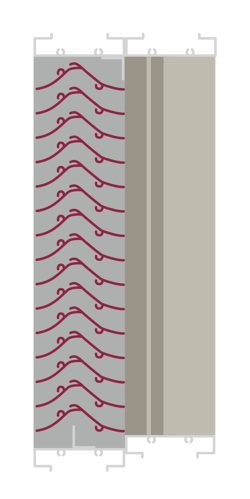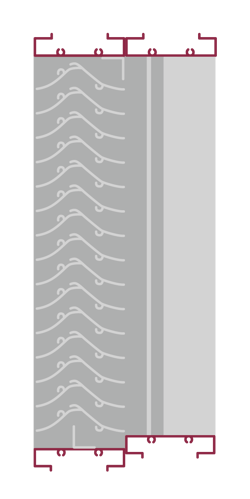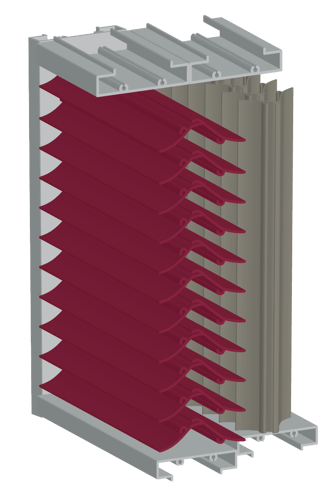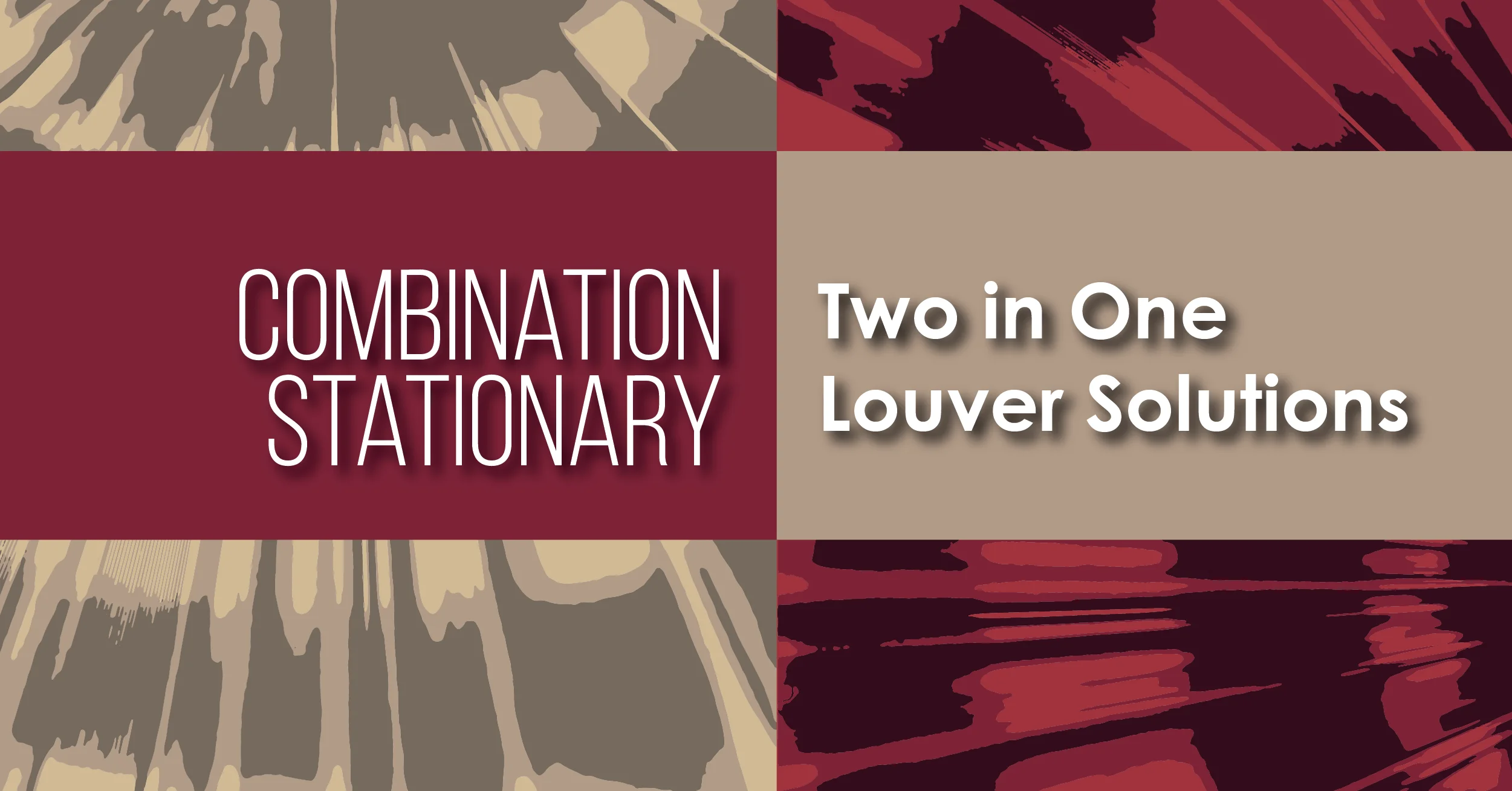Learn how combination stationary louvers protect interiors from severe weather events and hurricanes. These heavy-duty louvers offer protection and performance in one package!
The Importance of Severe Weather Protection
Selecting the right louver can be a difficult balancing act. It helps to have a louver with low pressure drop, to maintain an efficient HVAC system, but there are times when you will need to sacrifice air performance for better protection. For instance, your project may call for louvers built for hurricanes or other severe weather scenarios.
Severe weather louvers will need to be resilient against heavy rainfall carried by storm force winds. Protective features, like drainable troughs and catches, will affect air performance. You need every louver to protect your ventilation openings from rainfall, while allowing air through at the required airflow rate. Read "Maximizing Efficiency with Louvers" to learn more about the effects of louvers on airflow. The best way to deal with this is to strike the right balance between protection and performance. There are louvers that can maintain this balance, while also meeting severe weather requirements.

Combination stationary louver are typically configured with forward-facing horizontal blades and rear vertical blades.
What is a Combination Stationary Louver?
Combination stationary louvers strike the balance between heavy duty protection and efficient air performance. These differ from combination adjustable louvers, which are often referred to as “combination louvers”. Similar names for two very different louvers. A combination stationary louver has two sets of stationary louver blades.
Blades are typically configured so that the face-side blades are horizontal, and the rear-side blades are vertical. Each set of blades is contained within a discrete frame. These discrete frames are combined to create a single combination stationary assembly. Think of it like attaching a second louver to the back of the first so that they are combined into one. Typically, the rear frame will be slightly smaller than the face-side frame.

Pictured are the two discreet frames of the combination stationary louver. Note the smaller size of the rear side louver.
Why use Combination Stationary Louvers?
It may seem excessive to combine two louvers into one unit. The resulting assembly would be a monster, and certainly too large for a standard ventilation opening. Combination stationary louvers can exceed eight inches in depth, but this is not true for every model. Manufacturers can design combination stationary louvers with smaller frames, creating a combined unit that is no larger than a standard wind driven rain louver. With a smaller form factor, you can install a combination stationary louver anywhere a wind driven rain louver might go.
It seems like adding a second set of blades would increase pressure drop, but it depends on the design. With a vertical-horizontal setup, the air stream will twist as it passes from the horizontal blades to the vertical blades, instead of dragging further along a second set of horizontal blades. In other words, the vertical blades can reduce the amount of pressure lost by the air stream while providing a second layer of protection against water infiltration. In some cases, the overall pressure drop is no greater than a standard wind driven rain louver. While they provide efficient air performance, combination stationary louvers are built for severe weather.
Combination Stationary Protection
Many combination stationary louvers are rated for wind driven rain protection. They reject incoming rain before it can potentially damage your ductwork. Certain combination stationary louvers provide hurricane protection, an important consideration for coastal projects. This protection includes resilience against impacts from windborne debris and protection from high velocity wind driven rain. Combination stationary louvers are often tested and rated in accordance with AMCA Standards 540 and 550 for severe weather protection.
Learn more about AMCA 540 and 550 with the Newsstand, including a breakdown of each test and why these ratings are important for hurricane and severe weather protection.
To put it simply, combination stationary louvers provide top-tier protection from severe weather with a minimal impact on air performance.
The EA-631-D from Arrow United Industries

To demonstrate this, let’s take a look at a combination stationary louver from Arrow United Industries. The EA-631-D is a combination stationary louver with two sets of chevron blades. As you can see from the drawing, the face-side blades are configured horizontally while the rear blades are vertical. You may also notice the two frames connected back to face. Each frame is three inches deep, which are combined to make a total frame depth of six inches. Here are a few highlights:
- Six-inch depth: No larger than your average wind driven rain louver and will fit into many of the same openings with ease.
- AMCA 550 Rated: Tested and rated for high velocity wind driven rain protection, in accordance with AMCA Standard 550.
- Rated for Wind Driven Rain, too: Also tested and rated in accordance with AMCA Standard 500-L for wind driven rain protection with a Class A effectiveness rating.
- Air Performance: At 1000 fpm, the EA-631-D produces 0.17 inches w.g. of pressure drop; excellent severe weather protection with minimal impact on air performance.
- Built by MCDLG: Every louver and damper is built to meet your needs.
When starting your next project, consider using combination stationary louvers to meet your severe weather requirements. These louvers can provide all the necessary protection without sacrificing air performance. Strike the right balance between performance and protection.
For more on louvers, check out these Newsstand articles:
- The Condenser - Product Spotlight: The AS3D99VS
- AMCA 540 and 550: Tougher Tests for Hurricane Louvers
- Ten Important Traits of Highly Effective Louvers
What do you think of combination stationary louvers? Would you use them for your severe weather requirements? Let us know in the comments section below!
MCDLG is Here to Help!
MCDLG is here to help! We can help you meet your HVAC requirements, from start to finish.
New to the HVAC industry? Or maybe you need a fresher. Browse the MCDLG Newsstand for explanations on industry terms and stats. Learn the basics of louvers and dampers, and how to choose the right equipment for your next project.
MCDLG also offers continuing education courses through our Campus Portal on AEC Daily! Learn at your own pace through our online courses or schedule a webinar for any course and take a more traditional approach. Learn important HVAC principles and earn continuing education credits from a variety of institutions, including ASHRAE and AIA.
Maybe you have a question regarding a current or future project? MCDLG can help! Visit our contact page and leave us a message. We will gladly help you find what you need, whether its information or custom-built louvers and dampers. Let us put our 50+ years in the industry to work for you.
.webp?width=91&height=70&name=MCDLG%20Logo%20(Resize).webp)






